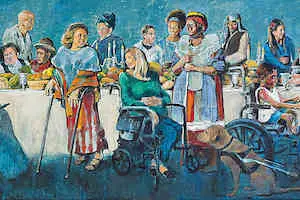Holy Trinity Brompton is located in one of the wealthier areas in London, and was once a “society church”. But Church of England attendances declined in the middle twentieth century until the Church was “headed towards marginal status”. In 1970, Holy Trinity Brompton (HTB) was in “dire financial straits”.
These days HTB is busy, hip, loud and successful. And almost single-handedly helping revive the Church of England’s fortunes.
There are many good things we can learn from HTB. If you are going to follow a conventional church form, this is surely the way to do it.
Sunday services at HTB
On Sundays the church is full with a wide variety of ages, ethnicities and types of people. You’re as likely to see a woman, or a non-Anglo leading or speaking as a white male.
The services are lively and follow a fairly conventional form (with one marked difference). The music is professional, the words sung are contemporary. There are announcements and prayers. There is a talk. So what makes it different and worth learning from?
Enthusiastic & positive
Everything is done with enthusiasm and positivity. Not overdone, but very much aimed at encouraging people in their faith and encouraging them to respond.
Shorter & practical
The talk is generally shorter than the average sermon, and aimed less at teaching and more to encourage and help in a practical way. This is good because it fits better with human psychology and how our brain works.
Transformation and the Holy Spirit
I think this is the key to HTB’s success. They don’t just rely on heartfelt worship and practical teaching, as many other churches do, but HTB allows substantial time in every service for a response from the congregation. Surely if we want to make committed mature disciples, we need to ask the Holy Spirit to be active, not just assume it?
The leaders ask for the Spirit’s involvement in the service, they ask the same at the end of the talk. They offer the opportunity for the members of the congregation to receive prayer for any matters raised in the service or any needs in their lives. If they believe the Spirit is wanting to care for some particular need, they say so.
All of this in a heartfelt and unhyped way.
Livestream
LIke many other churches, HTB set up a livestream during the pandemic. The livestream has continued, and now 700-800 people from around the world regularly join the livestream and the lively Chat that accompanies it.
But the Sunday service is only the tip of the iceberg. There is so much more to HTB.
Evangelism via Alpha
The old “attractional” model of evangelism (where members are encouraged to invite their non-believing friends to the services) isn’t very effective these days. Church services aren’t always an attractive place for a non-believer who will likely find some of it weird. Nor are they always structured to help a non-believer change their mind.
HTB’s answer to this dilemma is the Alpha Course, where church members can invite friends to an informal weeknight get together, perhaps with wine and food, to discuss in an informal atmosphere. “Stay curious” is the motto, and no question is off limits.
I have heard some serious criticisms of the Alpha approach, but it is very successful (in London at any rate) in bringing even hard core non-believers into faith and into the church.
Whatever the pros and cons, this is generally a better way to introduce Christian faith than inviting people to church.

Community transformation
Another standout feature of HTB is there social transformation programs.
- The massive Love Your Neighbour program was introduced by HTB at the start of the Covid pandemic, offering meals and support to those doing it tough, and to health workers putting in long and exhausting shifts. It quickly spread acoss the country and now there are “2,500 organisations helping people to overcome pressing social challenges by tackling the root causes of poverty through crisis support, debt advice, employment training and community care across the UK.” The team is now delivering a million meals a month.
- Love Christmas and Love Ukraine are separate programs under the Love your Nighbour banner.
- HTB ministers to prisoners in prison and on leaving prison.
- Other programs include debt and employment programs, day and night shelters for rough sleepers and homeless, a community cafe for refugees and asylum seekers and a women’s support program.
Courses for life
The church also runs life skills courses for members and anyone else interested. (The present associate vicar came into the church through a bereavement course.)
These courses generally run for 5-8 weeks and include addiction recovery, employment support, bereavement, anxiety, dating, marriage, divorce & separation (separate courses for parents and teens), eating disorders, parenting, money, and more.
The HTB network
The HTB church comprises 10 Sunday services in 6 different locations around the Kensington area in west London. In addition the church has sponsored new or revitalised congregations in churches around England which were in decline, or closed. Many of these renewed congregations have themselves planted new churches or helped revitalise others.
As a result, there is now a growing network of more than a hundred like-minded churches throughout UK (I haven’t been able to find an exact count). The Church of England is in decline, but these churches are bucking the trend.
An example
An example is Gas St Church in Birmingham, UK’s second largest city. Ten years ago a small team from HTB moved to Birmingham to establish a new mission-oriented church as part of an existing Church of England parish. Since then, the church has grown to hold 6 Sunday services over 3 locations (plus a livestream), and plant a number of churches nearby (and one in the Netherlands!). The church has a focus on music (writing many of their own worship songs) and its membership is young and diverse ethnically (as is Birmingham). There is a strong social transformation program.
Pastoral training
HTB has also supported the establishment of a ministerial training college (St Mellitus, named after the first Bishop of London in the 7th century) which has a focus on worship, prayer and mission. Notable in this is the Peter Stream, offering training to men and women who may have found it difficult to enter other training colleges or university because of education, ethnicity or gender, and the Caleb Stream, training retirees from secular work who want to use their gifts in ministry.
Many of the staff sent to churches and church plants in the HTB network were trained at St Mellitus.
How did the change occur?
The change began six decades ago, when a clergyman in a prayer meeting with his congregation unexpectedly experienced a blessing from the Holy Spirit. His ministry and the church were transformed as they “embraced the emotive praying with joyous, fun-filled services powered by ‘rock gospel’ praise and worship”.
Almost two decades later, he was appointed vicar of HTB, and built the congregation up to more than a thousand, many of them “media creatives, fashion models, bankers and lawyers”. He also influenced the clergymen who came after him, thus setting HTB on the path it is on today.
Learning from HTB
I am not a great fan of conventional church services. So why this apparent paeon of praise for HTB?
The HTB approach has its critics, both within the church and outside. Traditionalists tend not like its charismatic flavour and non-traditional approach. Non believing critics often think its services and Alpha Course are intellectually light and spiritually manipulative.
I don’t necessarily endorse all HTB does and thinks, but they provide a clear example of why we need some big churches and how they might best operate.
- Contemporary & relevant. The music is professional, the overall look and feel is contemporary and the talks and program are practically relevant.
- Inclusive & diverse. The congregation, the staff and the speakers are both male & female and diverse ethnically. (HTB is currently embroiled in a debate about gender inclusion. The senior leader has made some conservative statements on this, but in a previous church he was supportive of the LGBTQI community, so it isn’t clear yet how this debate will turn out.)
- Community focus. There is a genuine attempt to engage with and support the wider community in a loving and helpful way. Only a large and organised church could do the community work that HTB does.
- Thoughtful & open. They don’t seem to push conformity on non-essential matters, and there is a genuine attempt to help people understand their faith before they commit to it.
- Holy Spirit & prayer. Prayer is an important part of the life of the church and the services, and they seem to genuinely depend on the Spirit without looking fanatical or odd.
- Effective. HTB often summarises its purpose as “the evangelisation of the nation, the revitalisation of the church and the transformation of society”. They seem to be doing this.
In summary, HTB has a balance of the important elements of a church – Word, Spirit, Action & Community. I think there are other ways to achieve these aims (see links below), but there will always be denominational churches (for the near future at least).
If you are going to be a more or less conventional denominational church, this is a great model.

The underground in Tampa, Florida
An amazing church built around the mission of serving the different sub-communities around them.

The church of the future?
If the church of the present isn’t cutting it in the postmodern world, what might the church of the future look like?

A fresh way to be the church?
The church is losing ground in western societies. But what if we followed Jesus’ radical teachings about how to share him with others?
Photos: HTB Alpha
